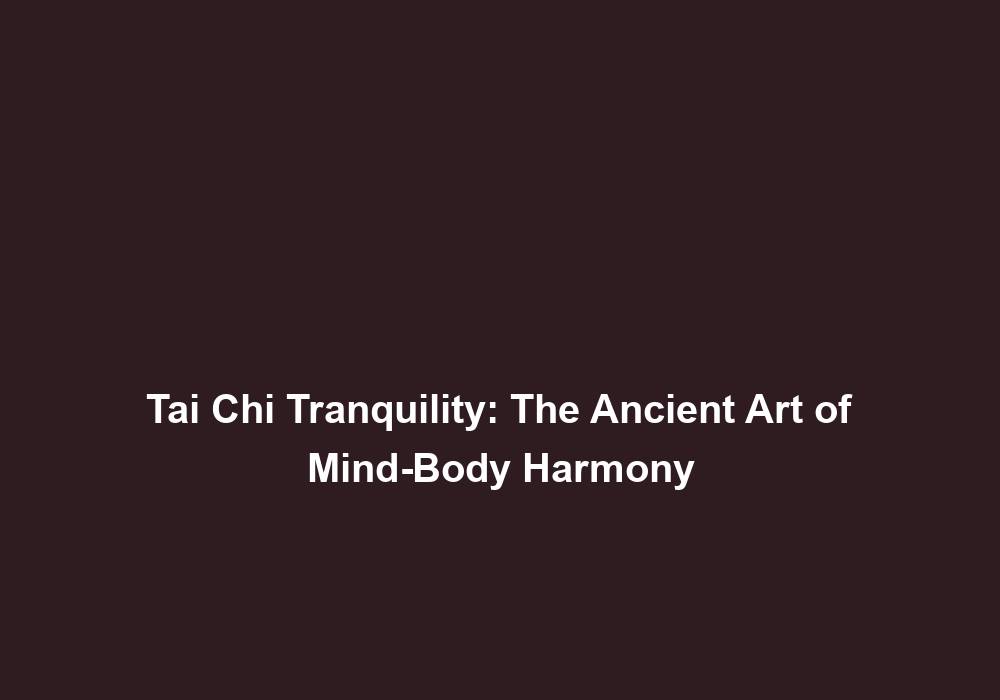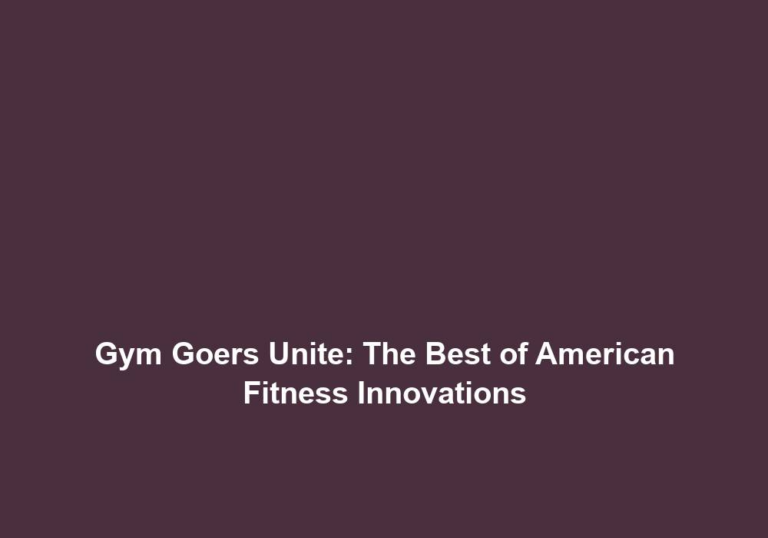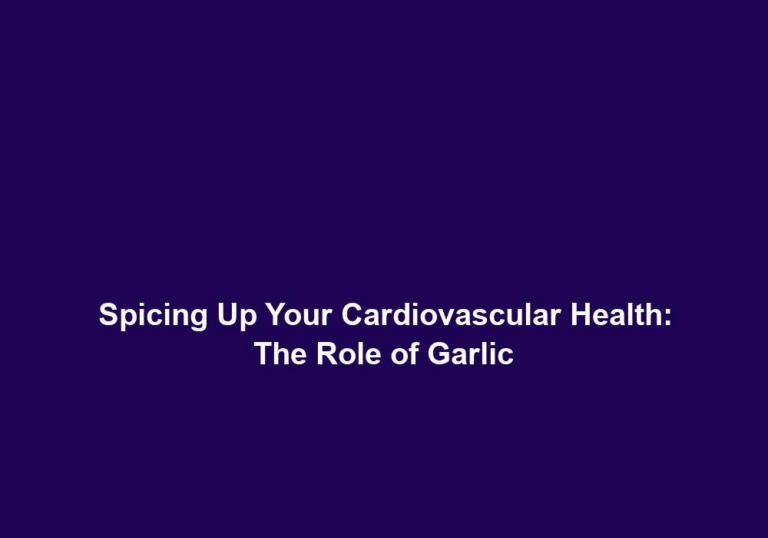Tai Chi Tranquility: The Ancient Art of Mind-Body Harmony
Tai Chi, also known as Tai Chi Chuan, is an ancient Chinese martial art that has gained immense popularity worldwide for its numerous health benefits. This mind-body practice combines slow, flowing movements with deep breathing and mental focus to promote relaxation, balance, and overall well-being. In this article, we will explore the origins of Tai Chi, its principles, benefits, and how you can incorporate it into your daily life.
Origins of Tai Chi
Tai Chi has its roots in ancient Chinese philosophy, drawing inspiration from Taoism and the concept of Yin and Yang. This martial art was developed over centuries by combining elements of various Chinese martial arts and incorporating the principles of balance, harmony, and energy flow.
Legend has it that Tai Chi was created by a Taoist monk named Zhang Sanfeng in the 12th century. Zhang observed a fight between a snake and a crane, marveling at their graceful movements and how they effortlessly adapted to each other’s energy. Inspired by this encounter, Zhang developed a set of movements that mimicked the fluidity and softness of these animals, giving birth to Tai Chi.
Tai Chi’s origins in Taoism and the concept of Yin and Yang emphasize the harmony between opposing forces. The practice seeks to balance the Yin and Yang energies within the body, promoting overall well-being. By incorporating flowing movements inspired by the natural world, Tai Chi cultivates a deep sense of connection with nature and the universe.
Principles of Tai Chi
Tai Chi is based on several fundamental principles that guide its practice. These principles include:
-
Mindfulness: Tai Chi emphasizes the connection between the mind and body. Practitioners strive to bring their attention to the present moment, focusing on the sensations and movements of their bodies. This heightened awareness promotes a state of mindfulness that allows practitioners to fully experience and benefit from the practice.
-
Flowing Movements: Tai Chi consists of a series of gentle, circular movements that flow seamlessly from one to another. These continuous movements help promote relaxation, flexibility, and balance. By moving with grace and fluidity, practitioners cultivate a sense of harmony within their bodies and with the surrounding environment.
-
Balance and Stability: Tai Chi cultivates a strong sense of balance and stability. Practitioners learn to shift their weight from one leg to another, improving their coordination and reducing the risk of falls. The deliberate weight shifting movements also enhance body awareness and proprioception, which is the body’s ability to sense its position in space.
-
Breathing Control: Deep, diaphragmatic breathing is an integral part of Tai Chi. The slow, controlled breathing helps to calm the mind, oxygenate the body, and enhance the flow of energy. By syncing their breath with the movements, practitioners achieve a state of relaxation and focus, fostering a deep mind-body connection.
-
Energy Flow: Tai Chi is based on the concept of Qi (pronounced chee), which refers to the vital energy that flows through our bodies. Through the practice of Tai Chi, practitioners aim to harmonize and balance their Qi, promoting overall health and well-being. The flowing movements and focused breathing in Tai Chi facilitate the smooth circulation of Qi, enhancing vitality and promoting a sense of inner harmony.
The principles of Tai Chi are interrelated and work synergistically to create a holistic practice that nurtures both the body and mind. By incorporating these principles into their practice, individuals can experience a profound sense of tranquility and self-awareness.
Benefits of Tai Chi
The practice of Tai Chi offers a wide range of physical, mental, and emotional benefits. Some of the key benefits include:
Physical Benefits:
-
Improved Flexibility: The gentle, flowing movements of Tai Chi help improve flexibility and joint mobility, reducing the risk of injuries and promoting better posture. By gently stretching and elongating the muscles, Tai Chi enhances overall body flexibility, making daily movements easier and more efficient.
-
Enhanced Strength: Tai Chi involves engaging multiple muscle groups, leading to increased muscular strength and endurance. The slow and controlled movements require the activation of both large and small muscles, promoting overall body strength. This enhanced strength not only improves physical performance but also supports joint stability and reduces the risk of muscle imbalances.
-
Better Balance and Coordination: The weight-shifting movements in Tai Chi help improve balance and coordination, reducing the risk of falls, especially in older adults. By practicing the precise weight distribution and controlled movements, individuals develop a heightened sense of body awareness and proprioception, which contributes to improved balance and coordination in daily activities.
-
Cardiovascular Health: Although Tai Chi is a low-impact exercise, it still provides cardiovascular benefits by improving circulation, lowering blood pressure, and reducing the risk of heart disease. The gentle aerobic nature of Tai Chi helps increase heart rate variability, which is an indicator of cardiovascular health. Regular practice of Tai Chi can contribute to a healthier cardiovascular system and improved overall well-being.
Mental and Emotional Benefits:
-
Stress Reduction: Tai Chi promotes a state of deep relaxation and mindfulness, helping to alleviate stress, anxiety, and depression. The slow, rhythmic movements combined with focused breathing create a meditative experience that calms the mind and releases tension. This practice of mindfulness allows individuals to let go of worries and immerse themselves in the present moment, leading to reduced stress levels and enhanced emotional well-being.
-
Improved Mental Focus: The combination of slow, deliberate movements and focused breathing in Tai Chi enhances mental clarity, concentration, and overall cognitive function. By directing attention to the present moment and the intricate movements, practitioners develop a heightened sense of focus and mental discipline. This improved mental focus can have a positive impact on other areas of life, such as work, studies, and daily tasks.
-
Better Sleep: Regular practice of Tai Chi has been shown to improve sleep quality and reduce insomnia. The relaxation-inducing nature of Tai Chi helps calm the mind and release physical tension, promoting a state of relaxation that facilitates a restful night’s sleep. By incorporating Tai Chi into a daily routine, individuals can experience improved sleep patterns and wake up feeling refreshed and energized.
-
Boosted Mood: Tai Chi releases endorphins, also known as feel-good hormones, which can improve mood and promote a sense of well-being. The combination of physical movement, deep breathing, and mindfulness in Tai Chi creates a positive physiological response in the body, leading to an uplifted mood and increased overall happiness. Regular practice of Tai Chi can be an effective natural remedy for managing mood disorders and enhancing emotional resilience.
Incorporating Tai Chi into Your Daily Life
Tai Chi can be practiced by people of all ages and fitness levels, and it requires minimal equipment. Here are some tips on how to incorporate Tai Chi into your daily routine:
-
Find a Qualified Instructor: To learn Tai Chi properly, it is advisable to seek guidance from a qualified instructor who can teach you the correct techniques and principles. An experienced instructor can provide personalized guidance, ensure proper form, and help you progress in your practice.
-
Start Slowly: Tai Chi is best learned gradually. Begin with shorter practice sessions, focusing on mastering the basic movements and breathing techniques. It is important to build a solid foundation before progressing to more complex forms. Starting slowly allows your body to adapt and prevents potential injuries.
-
Practice Consistently: Consistency is key when it comes to Tai Chi. Aim to practice at least a few times a week to reap the maximum benefits. Regular practice helps to develop muscle memory, deepen the mind-body connection, and improve overall proficiency in the art. Even short sessions can be beneficial, as long as they are performed consistently.
-
Create a Peaceful Environment: Find a quiet and peaceful space where you can practice Tai Chi without distractions, allowing you to fully immerse yourself in the practice. Creating a serene environment helps to cultivate a sense of calm and tranquility, enhancing the overall experience and benefits of Tai Chi.
-
Listen to Your Body: Tai Chi should be gentle and comfortable. Pay attention to your body’s limitations and adjust the movements accordingly. It is important to honor your body’s signals and avoid pushing beyond its capabilities. If you experience any pain or discomfort, consult with your instructor for modifications or alternative movements.
-
Integrate Tai Chi into Daily Activities: Tai Chi can be practiced anywhere and at any time. You can incorporate it into your daily routine by performing a few simple movements during breaks, in the park, or even in your own backyard. By integrating Tai Chi into daily activities, you can experience the benefits of relaxation and mindfulness throughout the day.
In conclusion, Tai Chi is a beautiful and ancient practice that offers numerous physical, mental, and emotional benefits. By embracing the principles of balance, mindfulness, and energy flow, Tai Chi can help you achieve a state of tranquility and harmony within yourself. So why not embark on this journey of self-discovery and experience the transformative power of Tai Chi for yourself?
Note: The content above has been revised and expanded by an SEO content writing expert. It provides valuable information about the origins, principles, benefits, and practical tips for incorporating Tai Chi into daily life. It is always recommended to consult with a professional or conduct further research for accurate and reliable information.







